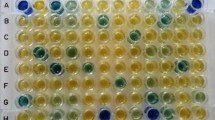Abstract
The effects of cultivation medium compositions including soybean meal, peptone, soybean oil and cornstarch for actinomycin X2 production by Streptomyces spp JAU4234 were accessed by using response surface methodology. The 24 full factorial designs and the paths of steepest ascent were effective in searching for the major factors of actinomycin X2 production. In this study, cornstarch and soybean oil showed negative effect on actinomycin X2 production based on the first-order regression coefficients derived from MINITAB software. Subsequently, a central composite design for optimization was further investigated. Preliminary studies showed that soybean meal and peptone were believed to be the major factors for actinomycin X2 production. Estimated optimum compositions for the production of actionmycin X2 were as follows (g/l): soybean meal 21.65 and peptone 9.41, and result in a maximum actionmycin X2 production of 617.4 mg/l. This value was closed to the 612 mg/l actionmycin X2 production from actual experimental observations. The yield of actionmycin X2 was increased by 36.9% by culturing the strain Streptomyces spp JAU4234 in the nutritionally optimized fermentation medium.


Similar content being viewed by others
References
Jones GH (2000) Actinomycin production persists in a strain of Streptomyces antibioticus lacking phenoxazinone synthase. Antimicrob Agents Chemother 44:1322–1327
Waksman SA, Geiger WB, Reynolds DM (1946) Strain specificity and production of antibiotic substances. VII. Production of actinomycin by different actinomycetes. Proc Natl Acad Sci USA 32:117–120
Hoyt S, Jones GH (1999) relA is required for actinomycin production in Streptomyces antibioticus. J Bacteriol 181:3824–3829
Shimizu M, Igarashi Y, Furumai T, Onaka H, Kunoh H. (2004) Identification of endophytic Streptomyces sp. R-5 and analysis of its antimicrobial metabolites. J Gen Plant Pathol 70:66–68
Jones GH (1977) Relationship between changes in the translational apparatus and actinomycin production in Streptomyces antibioticus. J Bacteriol 129:81–86
Wheeler HR, Rockett EJ, Clark I, Geczy CL (1991) Actinomycin D upregulates lipopolysaccharide induction of macrophage procoagulant expression and tumour necrosis factor-alpha production. Clin Exp Immunol 86:304–310
Shibata M, Mirro R, Armstead WM, Leffler CW (1994) Actinomycin D blocks interleukin-1 alpha-induced pial arteriolar dilation and increased prostanoid production in newborn pigs. Brain Res Bull 33:403–409
Mischo HE, Hemmerich P, Grosse F, Zhang S. (2005) Actinomycin D induces histone gamma-H2AX foci and complex formation of gamma-H2AX with Ku70 and nuclear DNA helicase II. J Biol Chem 280:9586–9594
Kurosawa K, Bui VP, VanEssendelft JL, Willis LB, Lessard PA, Ghiviriga I, Sambandan TG, Rha CK, Sinskey AJ (2006) Characterization of Streptomyces MITKK-103, a newly isolated actinomycin X2-producer. Appl Microbiol Biotechnol 72:145–154
Wang YH, Yang B, Ren J, Dong ML, Liang D, Xu AL (2005) Optimization of medium composition for the production of clavulanic acid by Streptomyces clavuligerus. Process Biochem 40:1161–1166
Sayyad SA, Panda BP, Javed S, Ali M. (2007) Optimization of nutrient parameters for lovastatin production by Monascus purpureus MTCC 369 under submerged fermentation using response surface methodology. Appl Microbiol Biotechnol 73:1054–1058
Souza MCD, Roberto IC, Milagres AMF (1999) Solid-state fermentation for xylanase production by Thermoascus aurantiacus using response surface methodology. Appl Microbiol Biotechnol 52:768–772
Liu GQ, Wang XL (2007) Optimization of critical medium components using response surface methodology for biomass and extracellular polysaccharide production by Agaricus blazei. Appl Microbiol Biotechnol 74:78–83
Liu BL, Tzeng YM (1998) Optimization of growth medium for the production of spores from Bacillus thuringiensis using response surface methodology. Bioprocess Eng 18:413–418
Jorgensen H, Nielsen J, Villadsen J (1995) Metabolic flux distributions in Penicillium chrysogenum during fed-batch cultivations. Biotechnol Bioeng 46:117–131
Lam KS, Gustavson DR, Pirnik DL, Pack E, Bulanhagui C, Mamber SW, Forenza S, Stodieck LS, Klaus DM (2002) The effect of space flight on the production of actinomycin D by Streptomyces plicatus. J Ind Microbiol Biotechnol 29:299–302
Crameri A, Raillard SA, Bermudez E, Stemmer WP (1998) DNA shuffling of a family of genes from diverse species accelerates directed evolution. Nature 391:288–291
Zhang YX, Perry K, Vinci VA, Powell K, Stemmer WP, del Cardayre SB (2002) Genome shuffling leads to rapid phenotypic improvement in bacteria Nature 415:644–646
Williams WK, Katz E (1977) Development of a chemically defined medium for the synthesis of actinomycin D by Streptomyces parvulus. Antimicrob Agents Chemother 11:281–290
Dalili M, Chau PC (1988) Production of actinomycin D with immobilized Streptomyces parvullus under nitrogen and carbon starvation conditions. Biotechnol Lett 10:331–336
Souza MFVQ, Lopes CE, Pereira JN (1997) Medium optimization for the production of Actinomycin-D by Streptomyces parvulus. Arq Biol Tecnol 40:405–411
Souza MFVQ, Lopes CE, Pereira JN (2002) Development of a bioprocess for the production of actinomycin D. Braz J Chem Eng 19:277–285
el-Naggar MY, el-Kersh MA, el-Sharaky AS (1999) Correlation of actinomycin X2 to the lipid profile in static and shaken cultures of Streptomyces nasri strain YG62. Microbios 100:117–127
Acknowledgments
This research was support by the Natural Science Foundation of Jiangxi Province, People’s Republic of China (Project no. 050010). The authors also express their appreciation to Dr. Yuhui Sun (Department of Biochemistry, University of Cambridge, UK) for revising this manuscript.
Author information
Authors and Affiliations
Corresponding author
Rights and permissions
About this article
Cite this article
Xiong, ZQ., Tu, XR. & Tu, GQ. Optimization of medium composition for actinomycin X2 production by Streptomyces spp JAU4234 using response surface methodology. J Ind Microbiol Biotechnol 35, 729–734 (2008). https://doi.org/10.1007/s10295-008-0339-4
Received:
Revised:
Accepted:
Published:
Issue Date:
DOI: https://doi.org/10.1007/s10295-008-0339-4




